AF 18~250 mm F/3.5-6.3 Di-II LD Aspherical [IF] - Tamron
AF 18~250 mm F/3.5-6.3 Di-II LD Aspherical [IF] - Tamron
AF 18~250 mm F/3.5-6.3 Di-II LD Aspherical [IF] - Tamron
You also want an ePaper? Increase the reach of your titles
YUMPU automatically turns print PDFs into web optimized ePapers that Google loves.
ATTACHING AND REMOVING THE LENS<br />
How to mount the lens<br />
Remove the rear cap of the lens. Align the lens attachment mark (15) on the lens barrel<br />
with its counterpart on the camera mount and insert the lens. Rotate the lens<br />
clockwise until it click-locks. For Nikon and Pentax models, align the lens attachment<br />
mark on the camera and the lens attachment mark (15) on the lens to attach the lens.<br />
For Nikon models, align the lens attachment mark with the dot on the camera and<br />
rotate the lens counter-clockwise until it click-locks.<br />
How to detach the lens<br />
Pressing the lens release button on the camera down, turn the lens counter-clockwise<br />
(in case of Nikon lens, clockwise), and lift the lens off the camera's lens mount.<br />
The image circles of <strong>Di</strong>-<strong>II</strong> lenses are designed to match the digital SLR cameras using the<br />
image sensors equivalent to APS-C (approx. 15.5 x 23.2<strong>mm</strong>). Do not use <strong>Di</strong>-<strong>II</strong> lenses with cameras<br />
using image sensors larger than APS-C. Using <strong>Di</strong>-<strong>II</strong> lenses with such cameras may cause vignetting<br />
on the image.<br />
Some Canon digital SLR cameras have index marks for attaching both EF lenses (red) and<br />
EF-S lenses (white) on the bayonet mount. To attach <strong>Tamron</strong> <strong>Di</strong>-<strong>II</strong> lenses, align the lens attachment<br />
mark on the lens (15) with the index mark for EF lenses (red). Do not forcibly align the indicator on<br />
the kens (15) with the index mark for EF-S lens (white). Doing so could result in damage to the lens<br />
and/or camera.<br />
For further details, please read the instruction manual of your camera.<br />
FOCUSING (Autofocus) (Ref. Figs 1 & 2)<br />
Switch the focusing mode switch of the camera to Auto focusing mode (<strong>AF</strong>) in case of<br />
Nikon, Sony, or Pentax. In case of Canon camera, switch the <strong>AF</strong>/MF switch (14) on<br />
the lens to <strong>AF</strong>. (Fig. 5). Press the shutter button lightly while viewing through the camera's<br />
viewfinder, the lens focuses automatically. An in-focus mark will light when the<br />
lens focuses on the main subject sharply. Press the shutter button further to photograph.<br />
When set on <strong>AF</strong> mode, interfering with focusing ring (8) may cause serious damage to the<br />
lens mechanism.<br />
For further details, please read the instruction manual of your camera.<br />
ZOOMING (Ref. Fig. 2)<br />
Rotate zooming ring (9) of the lens while viewing through the camera's viewfinder and<br />
compose your image at the chosen focal length.


![AF 18~250 mm F/3.5-6.3 Di-II LD Aspherical [IF] - Tamron](https://img.yumpu.com/27036201/6/500x640/af-18250-mm-f-35-63-di-ii-ld-aspherical-if-tamron.jpg)

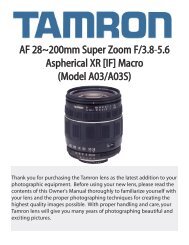
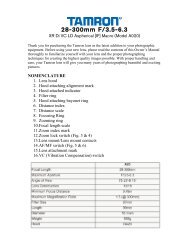
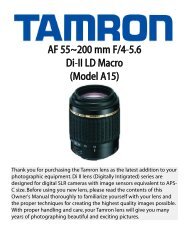
![SP AF 300mm F/2.8 LD [IF] for Canon (Model 360EE) - Tamron](https://img.yumpu.com/27036206/1/190x245/sp-af-300mm-f-28-ld-if-for-canon-model-360ee-tamron.jpg?quality=85)
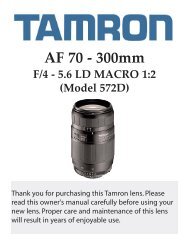
![SP AF17-50mm F/2.8 XR Di LD Aspherical [IF] - Tamron](https://img.yumpu.com/27036204/1/190x245/sp-af17-50mm-f-28-xr-di-ld-aspherical-if-tamron.jpg?quality=85)
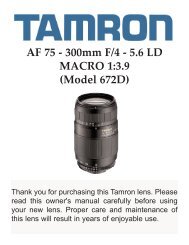
![AF28-300mm F/3.5-6.3 XR Di LD Aspherical [IF] Macro ... - Tamron](https://img.yumpu.com/27036194/1/190x245/af28-300mm-f-35-63-xr-di-ld-aspherical-if-macro-tamron.jpg?quality=85)

![SP AF 14mm F/2.8 Aspherical [IF] (Model 69E) - Tamron](https://img.yumpu.com/27036192/1/190x245/sp-af-14mm-f-28-aspherical-if-model-69e-tamron.jpg?quality=85)
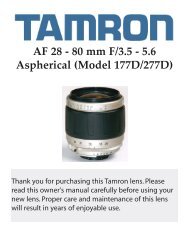
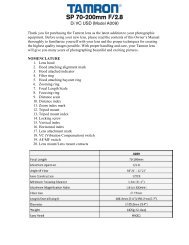
![SP AF 17~50 mm F/2.8 XR Di-II LD Aspherical [IF] (Model ... - Tamron](https://img.yumpu.com/27036181/1/190x245/sp-af-1750-mm-f-28-xr-di-ii-ld-aspherical-if-model-tamron.jpg?quality=85)